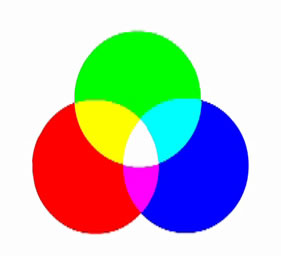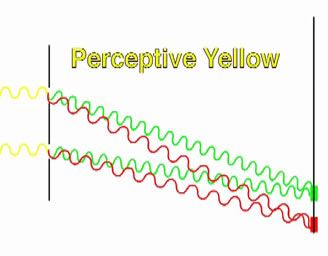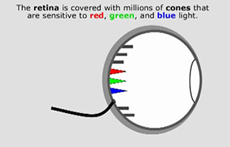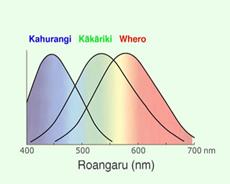Seeing Colours | Kitenga Tae
Introduction
Abstract
Human colour vision is explored in terms of cones and rods on the retina. The difference between perceptive and spectral colours is examined.
Principles Illustrated
Is it really true that the primary lights red and green combine to make yellow? Students explore this issue by comparing the behaviour of sound waves and light waves, learning how a combination of red and green “fool” the eye into seeing yellow by causing the same response in the cones. This resource would usually follow the introductory resource Is it Really Yellow?
Content
Instructions
A detailed teaching programme is available below. The human eye normally has three kinds of cones: ones that respond mostly to red light. ones that respond mostly to green light, and ones that respond mostly to blue light. Colour perception is based on the response of these cones to incoming light, and many combinations of wavelengths of light can appear the same. This resource would usually follow the introductory resource Is it Really Yellow?
This is the key point: the process of seeing something is actually pretty mechanical. Light from the object is directed by the focusing system (lens, cornea, etc) onto the retina. This is the formation of the image. The cones and rods on the retina generate electrical signals in response to the light, and those electrical signals are sent to the brain via the optic nerve.
All you get is those electrical signals. If two objects cause the same electrical signals to be sent to the brain, they will certainly look the same.
Yellow light (real spectral yellow, mid wavelength light) striking a part of the retina sets off the red cones and the green cones which then send data to the brain. The blue cones do not respond much. If red and green light together illuminate the same spot on the retina, the red and green cones will respond but the blue will not. The point is that red and green together cause the same electrical response in the cones that spectral yellow would. So they look the same.
Red, green, and blue (RGB) are called the primary colours of light or the primary lights. But there is nothing special about red, green, and blue light. They are just portions of the EM spectrum, no better and no worse than any other. Red, green, and blue do NOT combine to make other colours. Consider the case of red and green “combining to make yellow.” A low frequency wave (red) and a high frequency wave (green) will not combine to make a medium frequency wave (yellow). That’s just wrong physics (try it with sound waves). Red and green do not combine to make yellow, but they make you see yellow because they cause the same electrical response in the cones that spectral yellow would cause.
Essentially all of our image technology is based on this trick. A computer screen makes nothing but small dots of red, green, and blue (although new technologies that work a bit differently are now emerging). These RGB dots fool the observer into seeing other colours by causing the same electrical response in the cones that those colours would cause. See computer colours.






Detailed Teaching Programme
We have developed a successful teaching programme for colour perception that links together material from a number of demonstrations. Depending how the material is presented, we have found it works well with students from intermediate school right through to first-year university.
Other Information
Safety
Individual teachers are responsible for safety in their own classes. Even familiar demonstrations should be practised and safety-checked by individual teachers before they are used in a classroom.
Related Resources
He Kōwhai Rūkahu? (Is it Really Yellow?), Te Kokinga o te āhea o Ngā Whatu (Eye Resolution).
Notes, Applications, and Further Reading
The human eye perceives colours using three kinds of colour sensitive light detectors, called cones, on the retina. The colour responses of the three kinds of cones overlap quite a bit, but for simplicity we will call these red-sensitive, green-sensitive, and blue-sensitive cones. The colour information provided to the brain is determined by the response of the cones to the incoming light, so many combinations of wavelengths of light will appear the same to the human eye. Our favourite is the combination of red and green to make yellow but red and blue, or green and blue can also be used to give the perception of other colours. In fact, this is the basis of our image displays: TV sets, computer displays, cell phone displays, etc are all based on RGB technology in which combinations of Red, Green, and Blue are used to simulate other colours. You can find some useful discussion of human vision on the Hyperphysics web site among many others.
Credits
This teaching resource was developed by the Te Reo Māori Physics Project with support from
- Te Puni Kōkiri
- The MacDiarmid Institute
- Faculty of Science, Victoria University of Wellington
- School of Chemical and Physical Sciences, Victoria University of Wellington
- The New Zealand map shown on the poster frame above is used with permission from www.nz.com.
- We are grateful to Dr. Robert Jacobs, Associate Professor of Optometry at The Department of Optometry and Vision Science at Auckland University , for a number of useful conversations and suggestions.
- The human eye cone response graphic was adapted from one provided by Hyperphysics.
- This resource was filmed partly at Te Herenga Waka Marae.
- The butterfly is from the Natural Sciences Image Library.